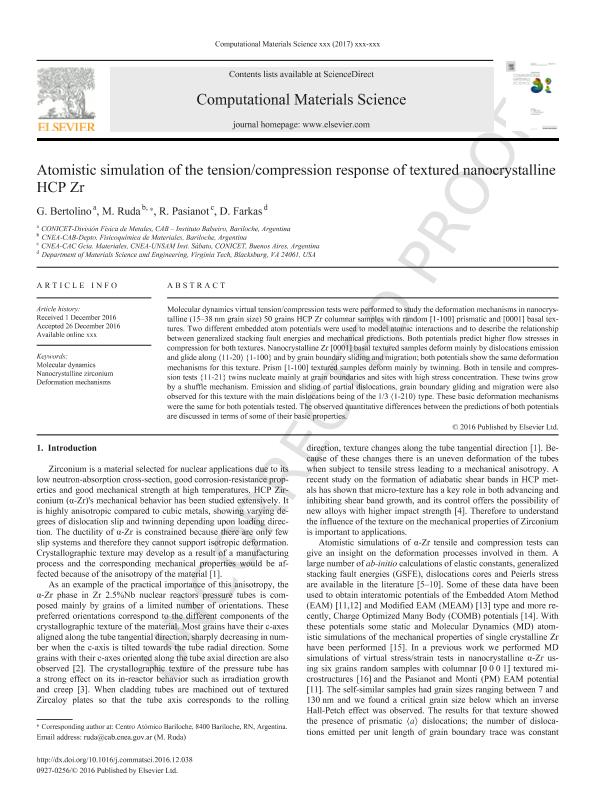Mostrar el registro sencillo del ítem
dc.contributor.author
Bertolino, Graciela Mabel

dc.contributor.author
Ruda, M.
dc.contributor.author
Pasianot, Roberto Cesar

dc.contributor.author
Farkas, D.
dc.date.available
2018-12-03T13:26:57Z
dc.date.issued
2017-04-28
dc.identifier.citation
Bertolino, Graciela Mabel; Ruda, M.; Pasianot, Roberto Cesar; Farkas, D.; Atomistic simulation of the tension/compression response of textured nanocrystalline HCP Zr; Elsevier Science; Computational Materials Science; 130; 28-4-2017; 172-182
dc.identifier.issn
0927-0256
dc.identifier.uri
http://hdl.handle.net/11336/65563
dc.description.abstract
Molecular dynamics virtual tension/compression tests were performed to study the deformation mechanisms in nanocrystalline (15–38 nm grain size) 50 grains HCP Zr columnar samples with random [1 −1 0 0] prismatic and [0 0 0 1] basal textures. Two different embedded atom potentials were used to model atomic interactions and to describe the relationship between generalized stacking fault energies and mechanical predictions. Both potentials predict higher flow stresses in compression for both textures. Nanocrystalline Zr [0 0 0 1] basal textured samples deform mainly by dislocations emission and glide along 〈1 1 −2 0〉 {1 −1 0 0} and by grain boundary sliding and migration; both potentials show the same deformation mechanisms for this texture. Prism [1 −1 0 0] textured samples deform mainly by twinning. Both in tensile and compression tests {1 1 −2 1} twins nucleate mainly at grain boundaries and sites with high stress concentration. These twins grow by a shuffle mechanism. Emission and sliding of partial dislocations, grain boundary gliding and migration were also observed for this texture with the main dislocations being of the 1/3 〈1 −2 1 0〉 type. These basic deformation mechanisms were the same for both potentials tested. The observed quantitative differences between the predictions of both potentials are discussed in terms of some of their basic properties.
dc.format
application/pdf
dc.language.iso
eng
dc.publisher
Elsevier Science

dc.rights
info:eu-repo/semantics/openAccess
dc.rights.uri
https://creativecommons.org/licenses/by-nc-sa/2.5/ar/
dc.subject
Deformation Mechanisms
dc.subject
Molecular Dynamics
dc.subject
Nanocrystalline Zirconium
dc.subject.classification
Ingeniería Mecánica

dc.subject.classification
Ingeniería Mecánica

dc.subject.classification
INGENIERÍAS Y TECNOLOGÍAS

dc.title
Atomistic simulation of the tension/compression response of textured nanocrystalline HCP Zr
dc.type
info:eu-repo/semantics/article
dc.type
info:ar-repo/semantics/artículo
dc.type
info:eu-repo/semantics/publishedVersion
dc.date.updated
2018-10-29T15:10:33Z
dc.journal.volume
130
dc.journal.pagination
172-182
dc.journal.pais
Países Bajos

dc.journal.ciudad
Amsterdam
dc.description.fil
Fil: Bertolino, Graciela Mabel. Comision Nacional de Energía Atómica. Gerencia de Área Investigaciones y Aplicaciones no Nucleares. Gerencia de Física (Centro Atómico Bariloche). División Física de Metales; Argentina
dc.description.fil
Fil: Ruda, M.. Comisión Nacional de Energía Atómica; Argentina
dc.description.fil
Fil: Pasianot, Roberto Cesar. Consejo Nacional de Investigaciones Científicas y Técnicas; Argentina. Universidad Nacional de San Martín. Instituto Sabato; Argentina. Comisión Nacional de Energía Atómica; Argentina
dc.description.fil
Fil: Farkas, D.. Virginia Tech; Estados Unidos
dc.journal.title
Computational Materials Science

dc.relation.alternativeid
info:eu-repo/semantics/altIdentifier/doi/https://dx.doi.org/10.1016/j.commatsci.2016.12.038
dc.relation.alternativeid
info:eu-repo/semantics/altIdentifier/url/https://www.sciencedirect.com/science/article/pii/S0927025616306656
Archivos asociados
